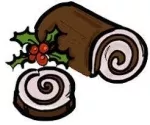Dec 21, 2018

Yule is observed on the day of the Winter Solstice according to nationaldaycalendar.com.
Also known as Jul, Yule predates the Christmas holiday by thousands of years. There is some debate as to the origin of the word Yule. Some linguists suggest the word is derived from “Iul”, the Anglo-Saxon word for wheel. This makes a connection to a Celtic calendar, the Wheel of the Year. In the Norse culture, “Jul” refers to the god, Odin. Odin was celebrated during Yule as well.
Yule celebrations included bonfires, decorating with holly, mistletoe and the boughs of evergreen trees, ritual sacrifices, feasts and gift giving.
Do you recognize any Christmas traditions borrowed from Yule?
The Yule midwinter feast usually lasted 12 days.
Vikings would decorate evergreen trees with gifts such as food, carvings, and food for the tree spirits to encourage them to return in the spring.
Mistletoe combined with a mother’s tears resurrected her son, the God of Light and Goodness, in a Viking myth. The Celts believe Mistletoe possessed healing powers as well and would ward off evil spirits.
In Norse tradition, Old Man Winter visited homes to join the festivities. The Viking god, Odin was described as a wanderer with a long white beard and is considered the first Father Christmas.
Viking children would leave their shoes out by the hearth on the eve of the winter solstice with sugar and hay for Odin’s eight-legged horse, Sleipnir.
Children would traipse from house to house with gifts of apples and oranges spiked with cloves and resting in baskets lined with evergreen boughs.
The Yule log was a whole tree meant to be burned for 12 days in the hearth. The Celts believed the sun stood still during the winter solstice. They thought by keeping the Yule log burning for these 12 days encouraged the sun to move, making the days longer. The largest end would be fed into the hearth, wine poured over it, and it would be lit with the remains of the previous year’s Yule log. Everyone would take turns feeding the length of timber into the fire as it burned. Letting it burn out would bring bad luck.
How To Observe
• Use #Yule to post on social media.
• Strengthen bonds with family and friends by visiting and/or exchanging gifts and greetings.
• Decorate your home with lights, greens, and holiday colors.
• Bless your home with a Yule wreath on your front door and sprigs of mistletoe inside.
• If you are part of a group, take up a collection of food and/or clothing at your Yule gathering and give what you collected to a social service agency to distribute to the needy (for example, Circle's Yuletide Charity Food Drive).
• Place sunflower seeds outside for wild birds to feast upon.
• Greet the Sun at dawn on Solstice morning by ringing bells.
• Light a candle for a more peaceful planet.
History
While the winter solstice is observed around the world, Yule was celebrated primarily by Germanic cultures of northern and western Europe. The midpoint of winter was a time to celebrate the rebirth of the sun and the light it would bring to the earth.
Share this article with friends!
Tags:
#yule#log,#christmas,#starzpsychics.com,#starzcast

